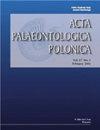Triassic coleoid beaks and other structures from the Calcareous Alps revisited
IF 1.9
3区 地球科学
Q2 PALEONTOLOGY
引用次数: 2
Abstract
A. 2022. Triassic coleoid beaks and other structures from the Calcareous Alps. Acta Palaeontologica Polonica 67 (X): xxx–xxx. We performed comprehensive study of seven Carnian, Late Triassic specimens of a coleoid cephalopod Phragmoteuthis bisinuata , on which Suess based his hypothesis on “beaks of P. bisinuata ”. Using SEM/EDS, we found that “beaks of P. bisinuata ” consist of a micro-granular carbonized matrix containing ~4–30 μm diameter and ~50–200 μm visible length, dense calcified bone-like micro-structures. This strongly suggests that these objects are vertebrate bone-inducing cartilages in which the matrix was post-mortem reworked by carbon-accumulating bacteria and substituted by nano-particles of carbon accumulated in micro-granules. Hence, the presumed “beaks of P. bisinuata ” are cartilaginous remains of a prey, presum-ably juvenile fish. This data dismissed the entire hypothesis of Seuss. A small spatula-shape plate with a rachis-like process in an association with 10 or so imprints around (arm crown), found in front of a proostracum of P. bisinuata evidences an unknown Late Triassic juvenile teuthid which possessed a gladius resembling that of the early Permian Glochinomorpha stifeli. It inhabited the open sea area of the northwestern Tethys Ocean, and was, along with juvenile fishes, in the diet of P. bisinuata . The first identified Anisian (Middle Triassic) coleoid beak is represented by an isolated specimen from the Gardena Valley, NE Italy. It has a typical composition and morphology of coleoid upper beak: chitinous, wide-oval lateral walls, short wings, and pointed hook-like rostrum. This suggests similar upper beak structure in the Carnian P. bisinuata in which the lower beaks were apparently similar to that of the co-occurring Lunzoteuthis schindelbergensis and had a widely open outer lamella with posteriorly elongated paired wings joined into a pointed rostrum in the anterior portion.从钙质阿尔卑斯山脉重新考察了三叠纪coleoid喙和其他结构
答:2022。来自阿尔卑斯钙质山脉的三叠纪胶体喙和其他结构。古生物学报67 (X): xxx-xxx。我们对卡尼期、晚三叠世的7个胶状头足类动物Phragmoteuthis bisinuata的标本进行了全面的研究,在此基础上,苏斯提出了“P. bisinuata的喙”假说。通过扫描电镜/能谱分析发现,“双翅鹤嘴”由直径~4 ~ 30 μm、可见长度~50 ~ 200 μm的致密钙化骨状微结构组成。这有力地表明,这些物体是脊椎动物的骨诱导软骨,其中的基质在死后被碳积累细菌重新加工,并被积累在微颗粒中的碳纳米颗粒所取代。因此,假定的“P. bisinuata的喙”是猎物的软骨残骸,可能是幼鱼。这些数据否定了苏斯的整个假设。在P. bisinuata的前体前发现了一个小刮刀形状的盘子,上面有一个棘状突起,周围有10个左右的印记(臂冠),这证明了一个未知的晚三叠世幼齿鱼,它拥有类似于早二叠世Glochinomorpha stifeli的剑鞘。它居住在特提斯洋西北部的开阔海域,与幼鱼一起,是P. bisinuata的食物。第一个被发现的安尼西亚(中三叠世)coleoid喙是来自意大利东北部加迪纳谷的一个分离标本。典型的上喙组成和形态:几丁质,宽卵圆形侧壁,短翅,尖钩状喙。这表明Carnian P. bisinuata具有类似的上喙结构,其下喙明显类似于共同出现的Lunzoteuthis schindelbergensis,并且具有广泛开放的外板,背面拉长的成对翅膀在前部连接成一个尖喙。
本文章由计算机程序翻译,如有差异,请以英文原文为准。
求助全文
约1分钟内获得全文
求助全文
来源期刊

Acta Palaeontologica Polonica
地学-古生物学
CiteScore
2.80
自引率
5.60%
发文量
36
审稿时长
12.5 months
期刊介绍:
Acta Palaeontologica Polonica is an international quarterly journal publishing papers of general interest from all areas of paleontology. Since its founding by Roman Kozłowski in 1956, various currents of modern paleontology have been represented in the contents of the journal, especially those rooted in biologically oriented paleontology, an area he helped establish.
In-depth studies of all kinds of fossils, of the mode of life of ancient organisms and structure of their skeletons are welcome, as those offering stratigraphically ordered evidence of evolution. Work on vertebrates and applications of fossil evidence to developmental studies, both ontogeny and astogeny of clonal organisms, have a long tradition in our journal. Evolution of the biosphere and its ecosystems, as inferred from geochemical evidence, has also been the focus of studies published in the journal.
 求助内容:
求助内容: 应助结果提醒方式:
应助结果提醒方式:


